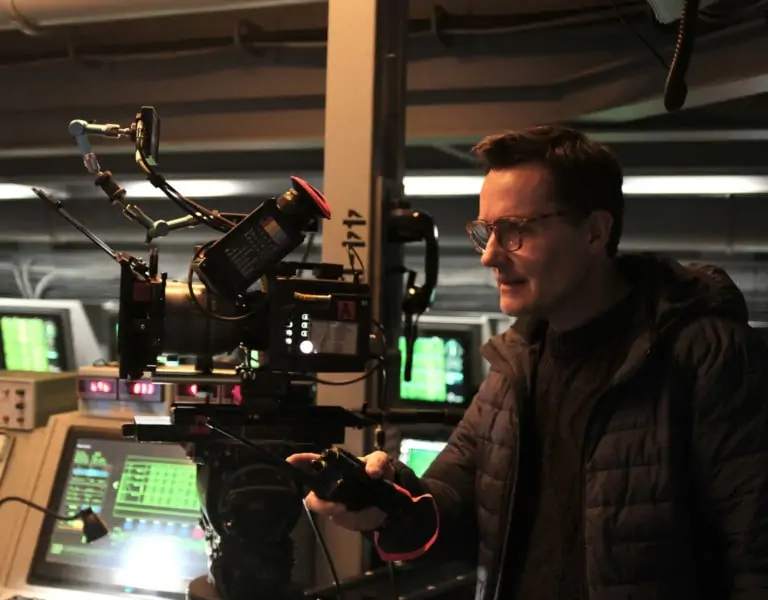TREASURES OF THE EARTH
When retelling the remarkable story of the Sutton Hoo excavation, cinematographer Mike Eley BSC and director Simon Stone adopted an elegant and distinctive visual style and handheld approach to convey the ethereal beauty of the rural locations and characters’ relationships as much as the wonder of the unearthed treasures.
“I like to get into the head of the director as much as possible early in the filmmaking process, first listening to their ideas and then augmenting them,” says cinematographer Mike Eley BSC. “I enjoy that stage when what they say triggers something in me and then we adapt the approach together.”
This was once again integral to the evolution of the visual language in Eley’s latest production The Dig. Adapted for the screen by Moira Buffini, the Netflix drama is based on John Prescott’s 2007 novel about the 1938 excavation of treasure in Suffolk’s Sutton Hoo.
Eley met with The Dig director Simon Stone after being put forward by the film’s producer Gabrielle Tana, who Eley had worked with on Ralph Fiennes’ The White Crow (2018). Their first conversation focused on a mutual interest in European history as much as it did on the vision for the production. “Simon is Australian but lives in Austria and is a real Europhile. We instantly clicked and I enjoyed his fresh way of thinking. He’s incredibly engaging, is wildly enthusiastic about film and his points of reference could be quite unexpected which was exciting,” says Eley.
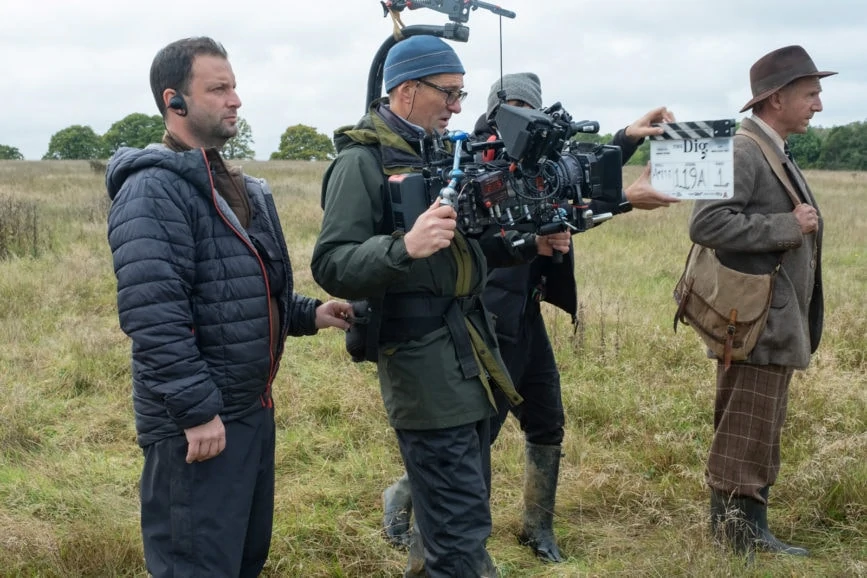
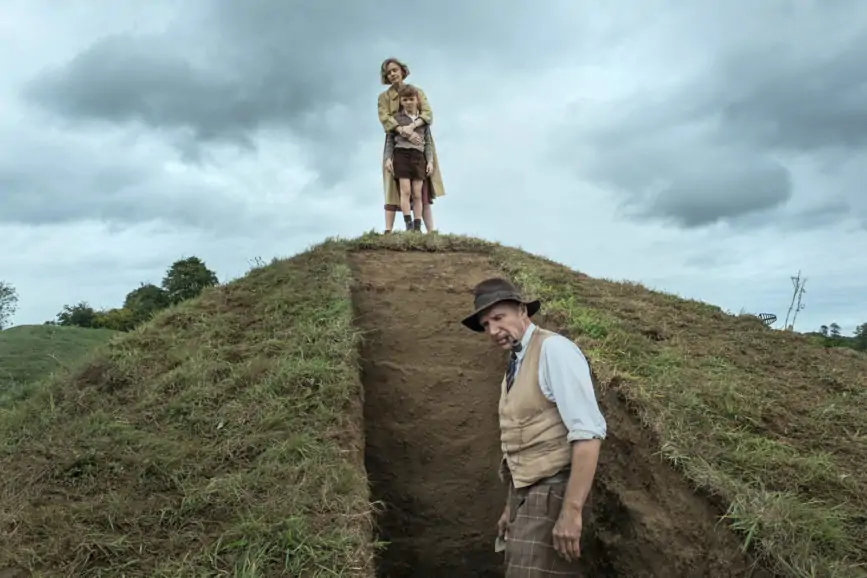
The cinematographer was already aware of the incredible unearthing of the 88-foot Anglo-Saxon burial ship containing precious artefacts which at the time represented the most significant discovery of its kind in England. But what he enjoyed most about the story of The Dig was its focus on the human element rather than the treasure. At the centre is the relationship between amateur archaeologist Basil Brown (Ralph Fiennes) and Edith Pretty (Carey Mulligan), the landowner who hires him to investigate the mounds on her estate.
“The low-lying human emotion underpinned the significant event of the dig and the fact life would soon be turned upside down by the second world war,” he says. “I thought this end of days feeling was beautifully handled in Moira Buffini’s script.”
With shooting delayed from August 2019 to the end of September, the crew enjoyed a lengthier prep period extensively exploring the creative and technical options and dedicating additional time to location scouting. As points of reference, Stone introduced Eley to new aspects of Eastern European cinema including films such as Jan Nemec’s war drama Diamonds of the Night (1964) and Earth (1930), Ukranian director Aleksandr Dovzhenko’s Soviet silent film about farmers’ uprising following a takeover.
At first, Stone was keen to call the production Earth in honour of Dovzhenko’s film. Although this was later decided against, the influence of the “almost experimental style of cinema” helped the director and Eley avoid getting too “stuck in the lockstep of the script and dialogue”.
Buffini’s script instantly brought to mind the beautiful large-format images captured by Eley’s friend and photographer Harry Cory Wright which were revisited for creative inspiration. “Harry shoots the Norfolk landscape and waterways which share some characteristics of where The Dig takes place in Suffolk. He rises early to capture the moment when the light is just appearing and the detail in his photographs is incredibly atmospheric,” he says.
As always, Eley spent as much time as possible with the art department early in prep, soaking up the history within the vast collection of reference pictures with “brilliant visionary” production designer Maria Djurkovic and her team. “We talked about the minutiae of a pocket watch or a telescope through to how we would create an 88-foot-long sunken ship,” he says. “It was a huge task to work out how to create the mounds that feature prominently in the narrative as well as the world around them.”
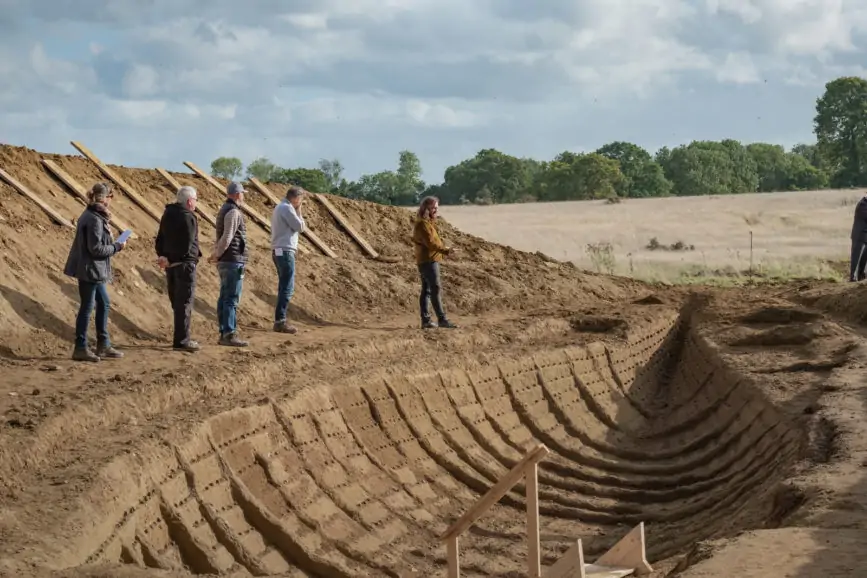
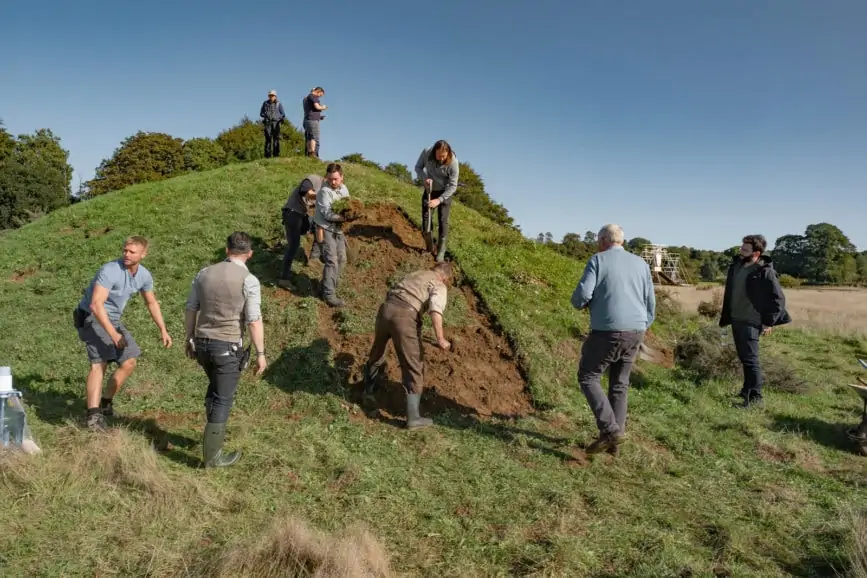
One challenge re-examined on multiple occasions was how to shoot most of the film in one field. Djurkovic, Eley and Stone’s discussions about what would need to be shot when and at what angles dictated the mounds’ placement. “If they were too close together you would see the second mound in scenes before it was revealed in the story,” he adds. “It was a jigsaw puzzle which Maria and the art department solved brilliantly based on where the camera needed to be positioned, giving us the freedom to shoot at about 280-degrees.”
Conversations about colour palette with the production design team resulted in the adoption of an earthy tone. “This was seen in the ochres, browns, yellows and faded greens of the costumes,” says Eley. “We also knew the grass in the field would be turning by October, so it would no longer be lush green. Once we started digging, we’d have the rich brown of the earth. Those were the colours we warmed to and encouraged. We weren’t going to make the colours pop. Instead, Simon wanted to achieve a slightly faded look similar to a 1970s movie print that had lost its full lustre.”
Working with Goldcrest colourist Adam Glasman, Eley developed a LUT in line with Stone’s desired colour palette. “As Simon wanted the sky a particular pale blue, not too piercing, accompanied by earthy shades, this became our working model for the LUT and was later taken into the DI. It was then a matter of finessing, adding grain for texture, adjusting some of the skin tones, and a little vignette to hone the focus.”

A LANDSCAPE-DRIVEN NARRATIVE
During moments of creative repose, inspired by filmic and photographic references, Stone and Eley decided how best to frame and showcase the landscape, which loomed large throughout prep and production and influenced choices including framing and aspect ratio. Stone favourited a more widescreen approach and a 2.39:1 aspect ratio to align with the landscape-driven story, but Eley felt 1.85:1 would offer extra height for the sky and that “it would be a shame to lose that sense of elevation in the compositions”.
I knew The Dig would be predominantly handheld, or close to handheld using the Easyrig, and consequently it was probably the most physically demanding film since I shot Touching the Void.
Mike Eley BSC
“Relatively late in the prep, Netflix became our backers. They favour the 2:1 aspect ratio so that helped finalise the decision,” says Eley. “It became a practical outcome that suited the film.”
The choice to shoot large format was made early on, partly influenced by Eley’s desire to adopt a similar large format approach to Cory Wright’s photography when capturing the landscape with the same scope and level of detail. “I knew The Dig would be predominantly handheld, or close to handheld using the Easyrig, and consequently it was probably the most physically demanding film since I shot Touching the Void. I initially felt the ARRI Alexa Mini LF would be well suited but as one wasn’t available, I worked with the Alexa LF Full Size camera. Once you decide to go down that route, you fully embrace it. As always, ARRI were very supportive, and they gave us an LF to test in the field,” says Eley, who had trialed the Alexa 65 when preparing to shoot My Cousin Rachel (2017).
“We didn’t have the budget for the Alexa 65 on that occasion, but I was really impressed by the camera and its prime lens options, especially the beautiful and immersive shallow depth of field of the portrait lenses. My experience of testing with the Alexa 65 stayed with me. I instinctively knew a large format sensor would work for The Dig which led me to the Alexa LF.”
The Dig’s handheld approach helped “keep the film alive” and allowed the characters to dictate where the camera should move. “We wanted to be respectful to the period, but not reverential to it, which this technique allowed,” says Eley. “I didn’t want to make it too rigid. It was a choreography between the camera and the actors. Simon would decide where to start and end the scene, but it was up to them what they did in between. This meant we did more takes than normal, but we always found something unexpected. That’s the joy of filming; finding an unintended juxtaposition or new composition.”
The cinematographer required a range of prime lenses to support The Dig’s two-camera set-up and capture the power and beauty of the locations and relationships. Having already been introduced to ARRI’s DNA LF lenses by Simon Surtees from ARRI Rental UK, Eley chose to work with the 21, 25, 29, and 35mm along with an Angenieux 24-290mm zoom lens on occasions.
“The DNA lenses were de-tuned at the wider end of the range – the 24mm and 29mm – by about 10% to bring in the edges slightly. These became the primary lenses for the film and were used not only for the wide shots, but when we moved around the characters in the field, transitioning to a mid-shot or a close-up to give some focus to those characters,” he says. “I also used the 21mm more than I would normally because it offered a great expansive feel.”
The speed of the DNA lenses was also valuable. Although he is “not a fan of shooting wide open just because you can”, for scenes such as the sequence which sees Edith’s health deteriorate, Eley ND’d down to wide open to help convey her nausea and light-headedness.
“Focus puller Marie-Sophie Daniel did an amazing job here as she’s brilliant at tapping into a scene’s emotion. The camera can make an actor look good, but it can also work the other way around. There can be a symbiotic relationship and close choreography between the two when an actor trusts the camera will find them,” says Eley. “Carey was incredible, too. She just allowed the camera to move around her and the focus was often found just by me breathing in and out with the camera and Marie-Sophie compensating when needed. It could have been chaotic, but it worked beautifully.”
Stone’s sensibilities were also “spot on” as he allowed the scene to continue, even when the dialogue had long run its course, resulting in a “wonderful ethereal moment”. The director’s willingness to explore unusual visual and sonic techniques was evident throughout the shoot. Like some of his earlier productions such as The Daughter (2015), the dialogue continued past the end point of select scenes. “It’s almost as if the characters’ thoughts are carrying on,” says Eley. “Simon wanted to incorporate that in The Dig to enhance the characters’ internal worlds and make the film feel timeless.”
While most of the story unfolds within the field, The Dig required a coordinated approach to shoot a pivotal scene in Suffolk when a Spitfire crashes into the river. Johnny Flynn, who played Rory Lomax, runs along the riverbank, and jumps into the water to attempt to rescue the pilot. “I must mention key grip Sergio Bernuzzi who rose to the challenge of working with fast-flowing water and all the safety precautions that come with that,” says Eley.
At the end of the 45-day shoot, the crew moved to Pinewood to film the latter part of the scene, with underwater cameraman Mark Silk capturing the Spitfire fuselage submerged in a tank. “Mark is incredible – we just briefed him and then watched on the monitor while he carried out these amazing moves through the water as Johnny dived in. The whole shooting environment was so un-Dig like for us and yet the almost spiritual encounter between Rory (Johnny) and the airman couldn’t have been done in any other way. The whole underwater team did brilliantly,” says Eley.
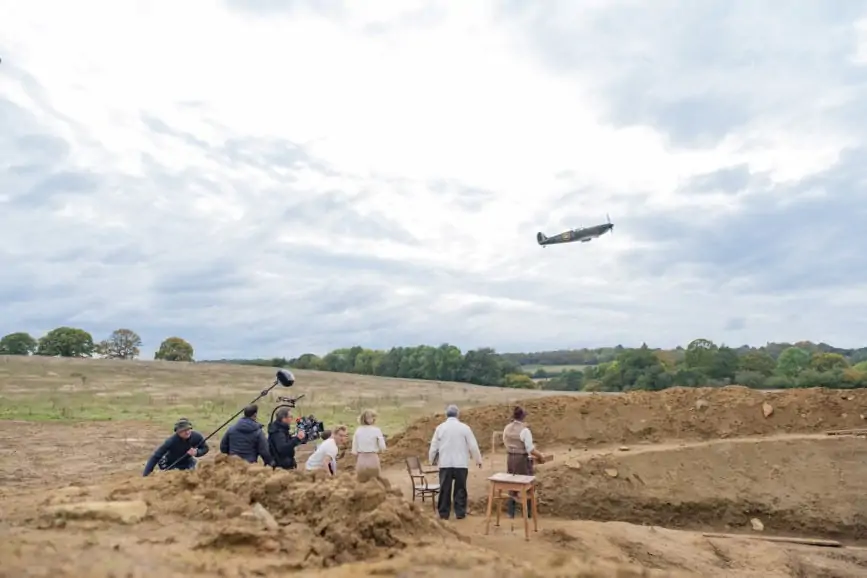
THE ESSENCE OF THE STORY
While the first few days of production are sometimes spent introducing the crew to the storytelling relatively gently, this portion of The Dig’s filming was “a significant logistical period”. The first week of the shoot took place in Suffolk, capturing scenes in locations such as Rendlesham Forest and Boyton Marshes.
“We were working with cranes, barges, and drones all in the first week, so it was an eventful start to the production, but this was good as it got the adrenaline pumping,” says Eley. “We were also blessed with great weather which allowed us to see the landscape, expansive skies and waterways that would help represent the essence of the story.”
Eley worked with Jeremy Braben and the Helicopter Film Services team during the initial week of shooting to capture aerial shots including a sequence of Basil frantically cycling to Ipswich and Edith walking along the path to the church. “Our rationale behind these shots was that they needed to be all about the land. In the early days, we considered cutting to a map or ordnance survey to explain that the story is about the characters in the land and in a country that has changed over the centuries,” says Eley. “The idea of looking down on the land was central to our thinking, so the drone footage was crucial in that storytelling. It was about capturing an exciting shot of Basil cycling, but also giving the audience a chance to see him within that landscape.”
The production later moved to Surrey, just south of Guildford, where the bulk of the film was shot and where the main field and house were located, and where the mounds that play a starring role in The Dig were created. The field selected needed to feel like an extension of the scenes that had been shot in Suffolk.
“Until we started digging, all we had were the field, horizon, and sky, so we did tests to explore how to make the composition interesting. Simon and I liked the idea of positioning the ground in the bottom fifth and filling the frame with sky,” says Eley. “It was all about the elements. For me, the sky denotes time through the passing of clouds and the sun. It’s nature’s clock allowing you to see a change in time which is what the film is about.”
This unusual and striking compositional technique is dotted throughout The Dig. In some sequences, almost the entire frame is filled with the mounds and the characters are placed in a small gap at the top to emphasise the presence of the earth.
The changeable weather experienced during the Surrey portion of the shoot was welcomed by the cinematographer who did not want wall-to-wall sunshine throughout filming. “Cloud cover is unpredictable but it’s photographically better to work with due to the cloud formations that make shots at dusk more interesting as the sun sets.”
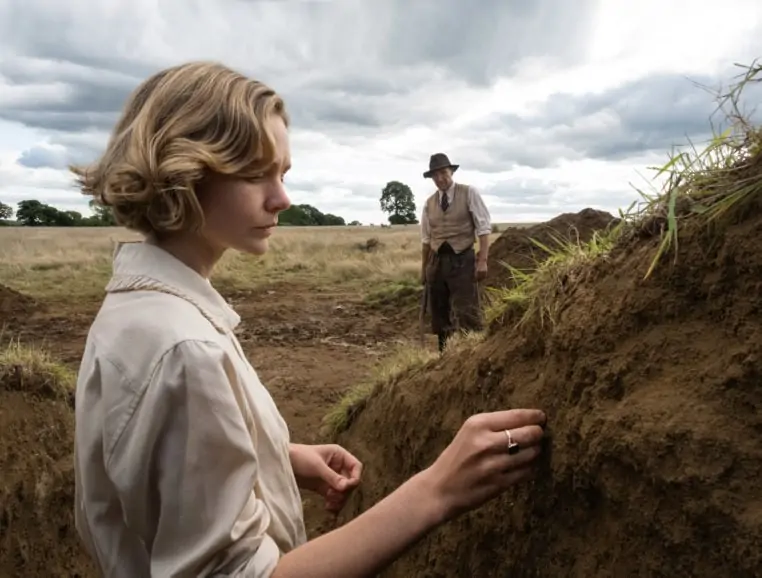
With much of the action taking place outdoors, the use of natural light was significant. The sun’s low position during the October shoot provided some incredible sunsets and dusk light but the speed at which it moved could prove challenging. “I wanted to shoot the exterior scenes in the field with natural light as much as possible and felt comfortable working with bouncing light off reflective material. We wanted to stay flexible and light on our feet but had 12×12 and 20×20 reflectors standing by if we needed to roll them in,” says the DP.
To add illumination and detail to the night sequences, two cranes were positioned on the horizon, where the land sloped downwards at the end of the field, with additional lighting offered by LED fixtures including ARRI SkyPanel S30, S60, S120 and S360 and a balloon light. “Gaffer Matt Moffatt also did a brilliant job lighting the scenes shot in the house. It was a great location, but we did not want to clutter the set with stands, so we mostly lit through windows using 12kW or 24kW HMIs. I try to avoid having lighting equipment on the floor of the set as I’d rather actors did not see the lights, so this set-up worked well.”
DIT Phoebe Fraser was another great ally on set and was Eley’s “second pair of eyes”. “It’s always reassuring working with Phoebe who has an eye on the creative element so it’s not all about waveforms and the technical aspect.” For the cinematographer, The Dig was a reminder of the importance of building a close-knit team of passionate and skilled professionals such as Fraser and also having enough time in pre-production. “You need valuable time in prep to source locations and equipment which some cinematographers fail to get,” he says. “It’s not enough to be shown locations that have already been chosen. You need to have input and be part of the conversation. That’s recognised by producers such as Gabrielle Tana who believes in the project and the script and wants to tell the story.”




